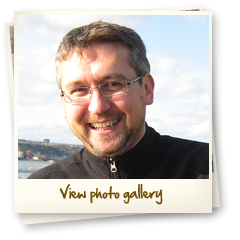

I was born in Belgrade, Former Yugoslavia (now Serbia). I was educated in Tehran (Iran), Belgrade (Serbia), North Haven (USA), Toronto (Canada), Sidney (BC, Canada), and New York (USA). I currently life in Halifax, Nova Scotia and work at Dalhousie University where I am an Associate Professor and Canada Research Chair in Geophysics and Petroleum Exploration. I also am associated with Columbia University in New York City where I am an Adjunct Research Scientist. I teach courses to undergraduate and graduate students, and supervise graduate students and post doctorate researchers. I also carry out research, mostly in controlled source seismology with particular focus on reflection imaging. I image subsurface structures in a similar way to ultrasound, which is used to image organs within a human being. I then use these images to study our planet.
Teaching, researching and learning about the Earth sciences are profoundly creative activities focused on resolving mysteries that are millions of years old. I cannot think of something more attractive to do for a living.
 Q: What is the title of your job and what do you do?
Q: What is the title of your job and what do you do?A: Associate Professor and Canada Research Chair in Geophysics and Petroleum Exploration at Dalhousie University; Adjunct Research Scientist at the Lamont-Doherty Earth Observatory of Columbia University.
I am a geophysicist with over 17 years of experience in reflection seismology and geological interpretation of seismic images. My work in academia and the petroleum industry has involved imaging methodology development, and collecting, processing and interpreting 2D, 3D and 4D seismic reflection data. These data were collected on land and at sea for various purposes, from exploration to environmental, and at various scales, from engineering to crustal. I am a Principal Investigator (PI) as well as co-PI on projects funded by the US National Science Foundation, Natural Sciences and Engineering Research Council of Canada, Canadian Foundation for Innovation, Nova Scotia Research and Innovation Trust, LDEO Climate Center and Vetlessen Foundation, as well as other organizations. My current research is focused on rifting and crustal accretion processes at intermediate- to fast-spreading centers, petroleum exploration at passive margins, subduction zone structure and seismic hazards, current deformation, and seismic oceanography.
A: I am based in Halifax, Nova Scotia, Canada.
A: No typical work hours/shifts. I work until I run out of time.
A: I work in my office, my lab, in the field on land and at sea, and in all corners of the world.

A: In the office and lab I use computers. In the field I use controlled source seismic equipment (air guns, vibrators and explosives to generate seismic waves; geophones and hydrophones, often thousands of them simultaneously, to detect waves that propagate through or reflect off the targeted structures; seismometers to record the detected seismic energy).
A: A doctorate (Ph.D.) in geophysics.
A: Strong interest in physics and geology.
A: Anywhere from $70,000 to $150,000.
A: Freedom to do whatever I want to do.
 Q: What are the advantages?
Q: What are the advantages?A: Freedom in what one chooses to do is the greatest benefit, and governs all other benefits as one can choose them based on personal preferences (e.g., extensive travel).
A: They are difficult to define and depend on personal interest.
A: It all depends as there is complete freedom in what one choose to focus their work on.
A: Because I like physics and geology, and because I like the freedom to choose to work on what I am interested in.

A: Driving a landrover in a salt desert in Iran when I was 8 years old (I had an early start as an Earth scientist).
A: In life, it is critical to do what you enjoy doing. However, often it is difficult to determine where your interests lie. During your early years at university take diverse subjects to see what is worth spending the next 40 years doing.
A: I am remarkably happy being an Earth scientist. You should give it a try.